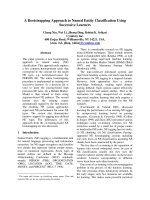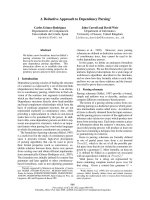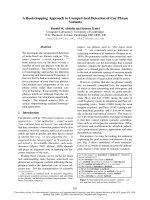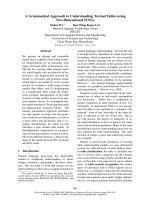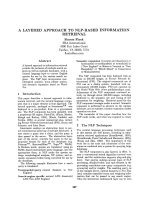Báo cáo khoa học: "A Corpus-Based Approach to Deriving Lexical Mappings" potx
Bạn đang xem bản rút gọn của tài liệu. Xem và tải ngay bản đầy đủ của tài liệu tại đây (185.35 KB, 2 trang )
Proceedings of EACL '99
A Corpus-Based Approach to Deriving Lexical Mappings
Mark Stevenson
Department of Computer Science,
University of Sheffield,
Regent Court, 211 Portobello Street,
Sheffield S1 4DP
United Kingdom
marks©dcs, shef. ac. uk
Abstract
This paper proposes a novel, corpus-
based, method for producing mappings
between lexical resources. Results from
a preliminary experiment using part of
speech tags suggests this is a promising
area for future research.
1 Introduction
Dictionaries are now commonly used resources in
NLP systems. However, different lexical resources
are not uniform; they contain different types of
information and do not assign words the same
number of senses. One way in which this prob-
lem might be tackled is by producing mappings
between the senses of different resources, the "dic-
tionary mapping problem". However, this is a
non-trivial problem, as examination of existing
lexical resources demonstrates. Lexicographers
have been divided between "lumpers', or those
who prefer a few general senses, and "splitters"
who create a larger number of more specific senses
so there is no guarantee that a word will have the
same number of senses in different resources.
Previous attempts to create lexical mappings
have concentrated on aligning the senses in pairs
of lexical resources and based the mapping de-
cision on information in the entries. For ex-
ample, Knight and Luk (1994) merged WordNet
and LDOCE using information in the hierarchies
and textual definitions of each resource.
Thus far we have mentioned only mappings
between dictionary senses. However, it is possible
to create mappings between any pair of linguistic
annotation tag-sets; for example, part of speech
tags. We dub the more general class
lexical map-
pings,
mappings between two sets of lexical an-
notations. One example which we shall consider
further is that of mappings between part of speech
tags sets.
This paper shall propose a method for produ-
cing lexical mappings based on corpus evidence. It
is based on the existence of large-scale lexical an-
notation tools such as part of speech taggers and
sense taggers, several of which have now been de-
veloped, for example (Brill, 1994)(Stevenson and
Wilks, 1999). The availability of such taggers
bring the possibility of automatically annotating
large bodies of text. Our proposal is, briefly, to
use a pair of taggers with each assigning annota-
tions from the lexical tag-sets we are interested in
mapping. These taggers can then be applied to,
the same, large body of text and a mapping de-
rived from the distributions of the pair of tag-sets
in the corpus.
2 Case Study
In order to test this approach we attempted to
map together two part of speech tag-sets. We
chose this form of linguistic annotation because
it is commonly used in NLP systems and reliable
taggers are readily available.
The tags sets we shall examine are the set used
in the Penn Tree Bank (PTB) (Marcus et al.,
1993) and the C5 tag-set used by the CLAWS
part-of-speech tagger (Garside, 1996). The PTB
set consists of 48 annotations while the C5 uses a
larger set of 73 tags.
A portion of the British National Corpus
(BNC), consisting of nearly 9 million words, was
used to derive a mapping. One advantage of using
the BNC is that it has already been tagged with
C5 tags. The first stage was to re-tag our corpus
using the Brill tagger (Brill, 1994). This produces
a bi-tagged corpus in which each token has two an-
notations. For example ponders/VBZ/VVZ, which
represents the token is ponders assigned the Brill
tag VBZ and VVZ C5 tag.
The bi-tagged corpus was used to derive a pair
of mappings; the word mapping and the tag map-
ping. To construct the word mapping from the
PTB to C5 we look at each token-PTB tag pair
285
Proceedings of EACL '99
and found the C5 tag which occurs with it most
frequently. The tag mapping does not consider
tokens so, for example, the PTB to C5 tag map-
ping looks at each PTB tag in turn to find the C5
tag with which it occurs most frequently in the
corpus. The C5 to PTB mappings were derived
by reversing this process.
In order to test our method we took a text
tagged with one of the two tag-sets used in our
experiments and translate that tagging to the
other. We then compare the newly annotated text
against some with "gold standard" tagging. It is
trivial to obtain text annotated with C5 tags us-
ing the BNC. Our evaluation of the C5 to PTB
mapping shall operate by tagging a text using the
Brill tagger, using the derived mapping to trans-
late the annotations to C5 tags and compare the
annotations produced with those in the BNC text.
However, it is more difficult to obtain gold stand-
ard text for evaluating the mapping in the reverse
direction since we do not have access to a part of
speech tagger which assigns C5 tags. That is, we
cannot annotate a text with C5 tags, use our map-
ping to translate these to PTB tags and compare
against the manual annotations from the corpus.
Instead of tagging the unannotated text we use
the existing C5 tags and translate those to PTB
tags. Each approach to producing gold standard
data has problems and advantages. The Brill tag-
ger has a reported error rate of 3% and so cannot
be expected to produce perfectly annotated text.
However, when we tag the text with PTB tags and
use the mapping to translate these taggings to C5
annotations we have no way to determine whether
erroneous C5 tags were produced by errors in the
Brill tagging or the mapping.
Our test corpus was a text from the BNC con-
sisting of 40,397 tokens. Both word and tag map-
pings were created in each direction (PTB to C5
and C5 to PTB). To apply the tag mapping we
simply used it to convert the assigned annotation
from one tag-set to the other. However, when the
word mapping is applied there is the danger that
a word-tag pair may not appear in the mapping
and, if this is the case, the tag mapping is used as
a default map.
The results from our evaluation are shown in
Table 1. We can see that the C5 to PTB word
mapping produces impressive results which are
close to the theoretical upper bound of 97% for
the task. In addition the word mapping in the
opposite direction is correct for 95% of tokens.
Although the results for the word mappings in
each direction are quite similar, there is a signific-
ant difference in the performances of the default
[ Type l
Word
Tag
Direction
C5toPTB PTBtoC5
97% 95%
86% 74%
Table 1: Mapping results
mappings, 86% and 74%. Analysis suggests that
the PTB to C5 default mapping is less successful
than the one which operates in the opposite dir-
ection because it attempts to reproduce the tags
in a fine-grained set from a more general one.
3 Conclusion and Future Work
This paper considered the possibility of producing
mappings between dictionary senses using auto-
matically annotated corpora. A case-study using
part of speech tags suggested this may be a prom-
ising area for future research.
Our next step in this research shall be to extend
our approach to map together dictionary senses.
The reported experiment using part of speech tags
assumed a one-to-one mapping between tag sets
and, while this may be reasonable in this situ-
ation, it may not hold when dictionary senses are
being mapped. Future research is planned into
ways of deriving mappings without this restric-
tion. In addition, we will also explore methods
for deriving mappings when corpus data is sparse.
References
E. Brill. 1994. Some advances in transformation-
based part of speech tagging. In AAAI-94,
Seattle, WA.
R. Garside. 1996. The robust tagging of unres-
tricted text: the BNC experince. In J. Thomas
and M. Short, editors, Using corpora for lan-
guage research: Studies in Honour of Geoffrey
Leach.
K. Knight and S. Luk. 1994. Building a large
knowledge base for machine translation. In
AAAI-94, Seattle, WA.
M. Marcus, B. Santorini, and M. Marcinkiewicz.
1993. Building a large annotated corpus of Eng-
lish: The Penn Tree Bank. Computational Lin-
guistics, 19.
M. Stevenson and Y. Wilks. 1999. Combining
weak knowledge sources for sense disambigu-
ation. In IJCAI-99, Stockholm, Sweden. (to
appear).
286
